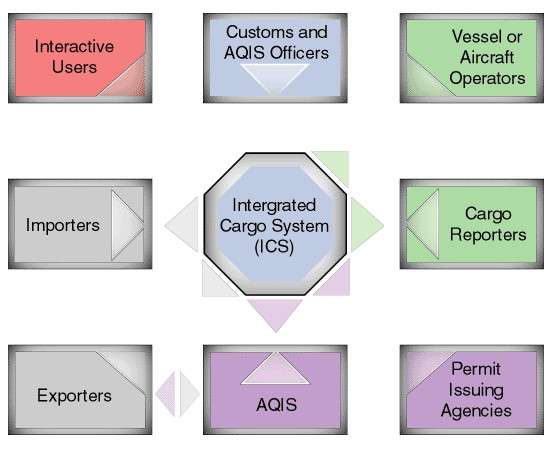The ICS User Context Diagram

The Integrated Cargo System (ICS) Context
The ICS is the Department's single system for the management of imports and exports. The system accepts information provided by importers and exporters as well as transport and logistics service providers and provides the Department and other government agency authority for cargo movement and clearance.
Legislation relevant to the ICS and the various messages processed by it is set out in the
Customs Act 1901.
The ICS
The ICS was developed by the Department to meet emerging industry and government needs for more effective and efficient management Australia's imports and exports.
The system may receive data interactively via a World Wide Web facility or through UN EDIFACT standard messages transmitted over the Internet as email attachments, by direct connect dedicated lines, or through Value Added, or Virtual Private Networks (VANs and VPNs). The system also receives export declaration data from the AQIS EXDOC system.
The ICS processes this information and responds, via the same mode as the inward message, providing cargo status or other information as appropriate.
The system also allows authorised users access to message status and process diagnostic information.
Accessing the ICS within the Departments
Officers access the ICS system through interactive interfaces. This access allows officers to undertake administrative, reporting and recording functions as required.
Officers are able to access reports as necessary and undertake research into data held in the ICS.
External Interactive Users
The ICS will be available to authorised users on the Internet through an interactive user interface. This is intended for use by small volume users or as a back up facility for occasions when the ICS may not be available through normal channels.
The interactive facility allows users to submit any of the reports available through email and provides access to sets of code listings, maintained by the Department. Interactive users can initiate the download of reference files from the ICS site.
The facility is designed to interact with sites meeting the minimum requirements including:
display settings set at 1024x768 pixels or above,
16 bit colour or better;
Microsoft Internet Explorer version 5.5 ( service pack 2) or better
Importers
Importers use the ICS to declare the import of goods to the Department of Home Affairs and the Department of Agriculture (if required). Import declarations may be made in a variety of ways, dependent on the details of the importation and the party involved. Importers may make a Full or a Self Assessed Clearance Declaration (SAC). A further method of declaring imported goods is available to importers participating in the Accredited Client Program. These importers may make a simple Request for Cargo Release (RCR) which is followed up by a monthly periodic declaration. The monthly periodic declaration contains a complete acquittal of all goods imported by the accredited client during the reporting period.
The Accredited Client Program is designed to streamline requirements for low risk importers and exporters.
Exporters
Exporters use the ICS to declare their intention to export goods meeting the criteria set out in the
Customs Act 1901. Declaration of exports requiring
Department of Agriculture approval may be made through a single message to the AQIS EXDOC system. Detail of information required varies dependent on the goods for exportation and the party making the report.
Exporters participation in the Accredited Client Program will be issued with Accredited Client Export Authority Numbers (ACEAN). These numbers represent authorities to deal with individual export shipments and may be passed to cargo reporters to indicate Customs approval to export. ACEANs are acquitted monthly through periodic declaration containing required detail of goods exported during the reporting period.
Further information on the Accredited Client Program can be found at the Home Affairs website
Department of Agriculture
The Department of Agriculture computer system EXDOC links to the ICS through the Single Electronic Window (SEW) facility. EXDOC users can report to the Department of Agriculture and have reports forwarded to the ICS to create export declarations. Customs export authority or other information is returned to the user through EXDOC.
The EXDOC system is used by exporters to report and clear goods requiring AQIS permits prior to exportation. Typically meat, fish, dairy produce and agricultural goods require Department of Agriculture permits.
Vessel/Aircraft Operators
Vessel and aircraft operators, including airlines and shipping companies use the ICS to report the arrival and departure of vessel and aircraft at / from Australian ports. These reports are used by the ICS to manage the reporting and clearance of goods.
Impending arrival and departure reports are made prior to the movement occurring. This allows the Department to undertake processing and clearance of the cargo and the vessel or aircraft, with minimal interference to the physical movement of the goods.
Cargo Reporters
Cargo reporters, such as airlines, shipping lines and freight forwarders, report the movement of cargo to the ICS. Cargo reports are generally made prior to the arrival or departure of the goods and allow the Department to undertake processing and clearance of goods, with minimal interference to the physical movement of the goods.
Electronic cargo reporting is mandatory.
Permit Issuing Authorities
The Department administers legislation for a range of Government Departments and Statutory Authorities. Many of these agencies have requirements for the reporting and control of certain classes of goods. Where control over the importation or exportation of goods is required, the responsible authority will typically require the use of Import/Export permits. The ICS validates permits and permit requirements providing notification to users when a quoted permit may not be valid, or when a permit is required but not quoted.